Ticks are insidious creatures that can spread disease to humans and domestic pets alike. Because they’re so hard to kill, many people find themselves at a loss when they find or suspect a tick infestation in their yard. Thankfully, getting rid of them isn’t as difficult as you might think.
How to get rid of ticks in yard? To get rid of ticks in your yard, get rid of lawn clippings, leaves, wood, and other debris that ticks can hide in. Then, create a border around the edge of your yard, remove plants that can attract potential animal hosts, and use homemade remedies and animal repellents to keep away tick carriers.
This article will take an in-depth approach to what you need to know about ticks, but most importantly, how to get rid of a tick infestation in your yard.
Tick Identification
Identifying ticks can be tricky because of how small they are, but it’s important to learn the identifying characteristics of ticks so you can better determine when you may have a tick nest in your yard.
What Does a Tick Look Like?
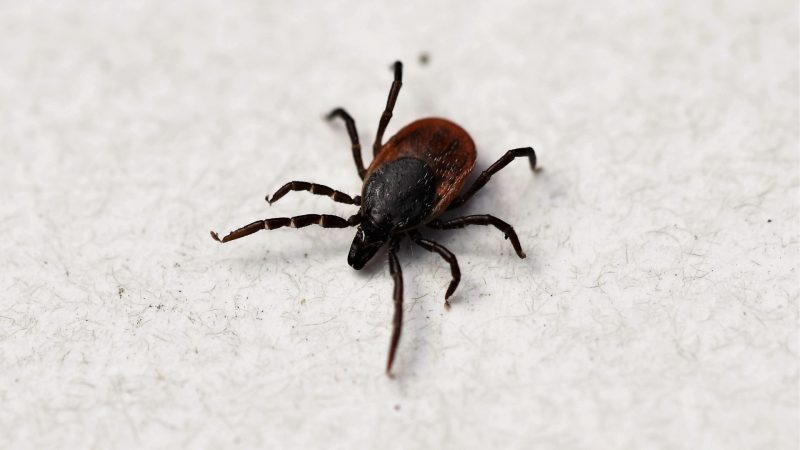
Ticks are very small bugs with rounded bodies, between 6 to 8 legs, and a set of scary-looking jaws they use to latch onto animals and humans. These jaws enable the tick to feed for hours at a time and engorge themselves in blood.
How Big Are Ticks?
Ticks are typically the size of a sesame seed, making them very hard to spot on the ground. When ticks engorge themselves on blood for several days, they can swell to several times their normal size.
Tick larvae are a mere 1-2 mm (0.04-0.08 in) long, and nymph ticks can be as small as a pinhead. For this reason, nymph ticks are often the toughest type of ticks to identify and root out of a yard.
How Many Legs Do Ticks Have?
Tick larvae have only 6 legs, but adult ticks have 8 legs. While they’re commonly called insects and bugs, ticks are actually considered arachnids in the animal kingdom and are related to spiders and scorpions.
How Long Do Ticks Live?
The lifespan of a tick varies widely depending on the species, but the average tick lives around 6 months. American Dog Ticks can live three years, and deer ticks can live up to three years.
Where Do Ticks Come From?
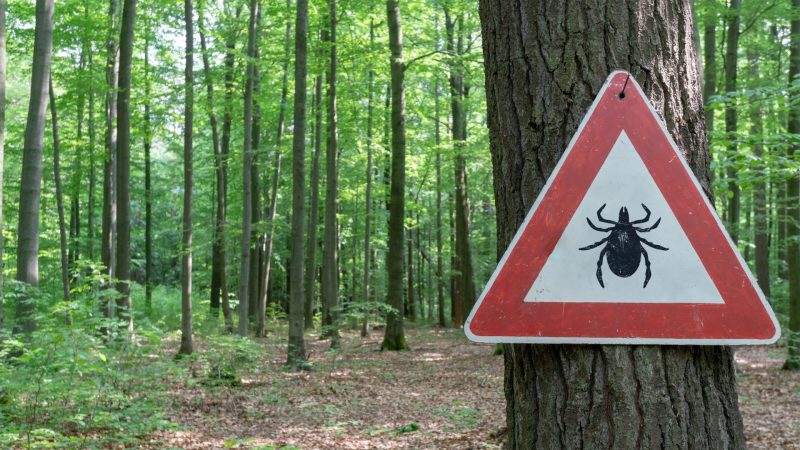
Ticks’ natural habitats tend to be woody and grassy, where many of their hosts (rodents, deer, birds, lizards, etc.) live. However, you can also find them in urban areas and even beaches where suitable hosts frequent.
Ticks also favor moist and humid areas close to the ground, especially during their larvae stage. One of the most common places for ticks to create nests is under piles of decomposing leaves, rotting wood, and piles of trash. Stone and rock walls retain moisture, too, making them perfect tick nests.
When Are Ticks Most Active?
Depending on where you live, ticks may be active all year long. Tick activity, however, typically peaks from April through September. It rises when the weather warms and both humans and animals are more active outside.
Different Types of Ticks
There are many different tick species, but the ones listed below are the most commonly encountered in residential areas.
- American dog ticks, aka ‘wood ticks,’ are usually flat, oval, and brown in color. They may have light-colored markings on their body.
- Blacklegged ticks, aka ‘deer ticks,’ have black legs and heads with a reddish-colored body.
- Rocky Mountain wood ticks look similar to dog ticks with flat oval bodies, but they become gray when engorged on blood.
- Lone Star ticks have a reddish body like black-legged ticks, but females are distinguished by a white mark or ‘lone star’ on their backs.
How Dangerous Are Ticks?
What Diseases Do Ticks Carry?
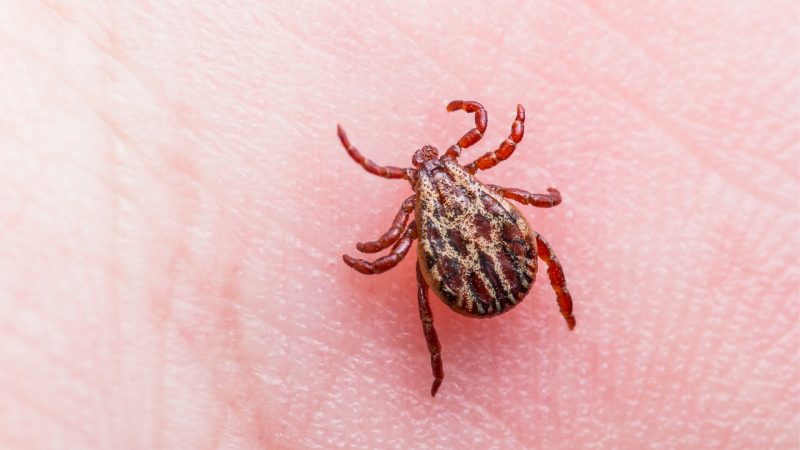
The most well-known disease that ticks carry is Lyme disease, which produces a ‘bullseye’ type rash at the site of a tick’s bite in concert with joint pain and flu-like symptoms, but there are numerous other diseases that ticks can pass onto people.
Some other diseases ticks can carry are:
- Babesiosis – is carried by black-legged ticks and causes parasites to infect red blood cells. The condition can be deadly to the elderly or immunocompromised.
- Meat allergies – can be caused by Lone Star tick bites and may present alongside allergy-like symptoms such as hives or anaphylaxis.
What Ticks Carry Lyme Disease?
Black-legged ticks and Western black-legged ticks both carry the bacteria that causes Lyme disease in humans. Not all types of ticks carry the bacteria that causes Lyme disease, but it’s necessary to treat all ticks as if they do carry it.
What Does a Tick Bite Look Like?
Tick bites usually look like a red bump, similar to a mosquito bite. Because it appears innocuous and/or maybe in a place the person can’t easily inspect, such as their back, many people may not even realize a tick bit them.
If the tick carries a disease, such as Lyme disease, a rash can appear at the site of the bite as long as a month later.
Why is My Yard Full of Ticks?
Ticks go where they can find suitable hosts to attach to and feed on, and they also need habitats close to those hosts. If you have pets that go outdoors, such as cats or dogs, they would be the ideal targets for any nearby ticks.
Also, ticks will be in your yard if there are many places for them to hide and breed, such as piles of wood, trash, leaves, or areas where moisture can gather.
Where Are Ticks Found in a Yard?
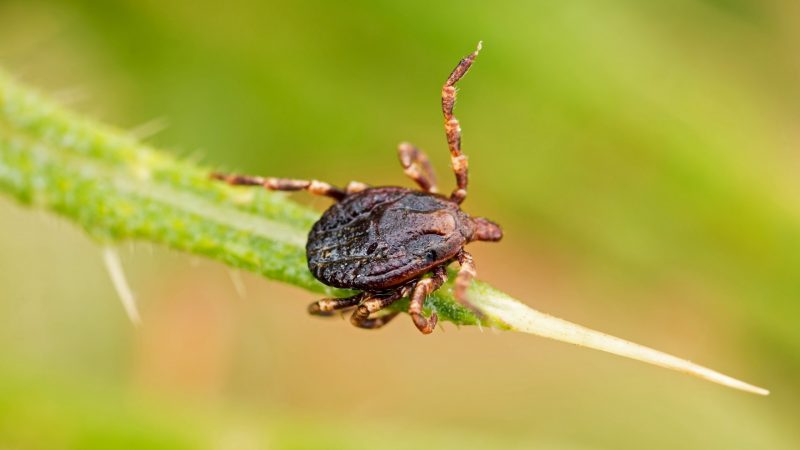
Ticks can be found anywhere in the yard they can hide, preferably in moist and shady areas; they avoid sunny and dry areas. Tall grass and weeds are perfect for ticks to lie in wait for a host, as are piles of leaves or tree limbs. Bushes and vegetation are common places for ticks to hang out or anywhere that debris collects in a yard.
Stone walls and any type of stone in a yard can be a hotbed of tick activity because stone retains moisture and makes for an optimal habitat. If you have a pet, observe where they go in your yard so you can determine if those areas are a likely hiding spot for ticks.
How Do I Know if My Yard Has Ticks?
1. Tick Dragging
Take a light towel or sheet and drag it over the yard. When you have thoroughly checked the sheet for ticks after pulling it through the yard, take it to a spot without any grass, such as a driveway. If you spot a tick, it should be packed in a Ziploc bag before being destroyed.
2. Check Your Pets
After your pets enter the house, check them. If you discover ticks on your outdoor dogs, there is a significant probability that they are bringing ticks from your yard. It is advised to run fingers through a pet’s hair and gently press down to feel for any lumps to check for ticks.
How To Get Rid of Ticks in Your Yard? | Step-by-Step Instructions
To get rid of ticks in your yard, there are steps that you need to take that are aimed at making your yard a hostile environment for ticks, in addition to killing ticks that currently live there.
Step 1: Clear Out Your Yard
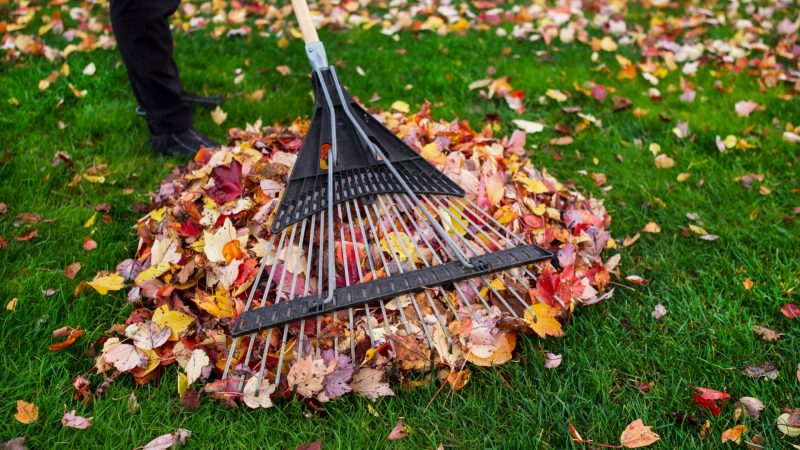
The first step to getting rid of ticks is to deprive them of suitable living conditions, which means cutting your grass regularly and, more importantly, getting rid of the clippings. The same goes for any trees, shrubs, or other vegetation in your yard.
Ticks especially need places to hide in the winter, so keeping your yard free of leaves, wood, and other debris is an important step to ridding your yard of ticks all year round.
Step 2: Create a Border Around Your Yard
Creating a 3 inches (7.62 cm) border of natural wood chips or small gravel around the edge of your yard is a very effective deterrent for any ticks that might try to cross into your yard. Ticks cannot jump, and physical hurdles such as these will usually cause them to look for hosts elsewhere.
Step 3: Keep Potential Animal Hosts Away

Animals such as deer and rodents are the most common wild hosts ticks tend to infest. As such, it only makes sense to deter these animals from giving ticks a free ride into your yard.
Removing plants that deer and rodents like is a good step, but you’ll need to research what plants local to your area attract these animal hosts.
Using a product like Safer Brand Critter Ridder or other commercially available deer repellants is a good idea. Still, you’ll need to monitor to see if it actually works; deer in some areas are known to approach yards whether deer repellant was used there or not.
- Repels skunks, groundhogs, dogs, cats, squirrels and raccoons
- Repels nuisance animals by scent and taste
- Long lasting formula provides up to 30 days of protection
- Shake well before use on garbage bins, plants, mulch, or other...
- Dries odorless to humans
Step 4: Use a Tick Killer
Permethrin and Talstar are two of the most effective products available for killing ticks, and there are several natural solutions that can be used to kill ticks in yards as well. No matter what you choose, applications should be very liberal and frequent to ensure you kill all the ticks within the yard.
Best Product To Get Rid of Ticks in a Yard
Permethrin and Talstar are the two most commonly used tick-killing products available in commercial formulations, and each has its pros and cons.
Permethrin tends to be cheaper than Talstar, but it doesn’t last as long after initial applications. On the other hand, it kills pests much faster after being applied to your yard. Keep in mind that permethrin is the name of the chemical and is used in many products for various insect-related applications, such as SaverPak JT Eaton Insect Repellent Spray.
- Insect Repellent: Permethrin Clothing & Gear treatment Ready Mix...
- 1 Gallon capacity treats up to 40 complete outfits. Will not...
- Ready to use water based 0.50% permethrin spray with no mixing or...
- This product is also registered for use in Space Spraying - For...
- For Indoor Application - To kill and control cockroaches, water...
Talstar is more expensive than permethrin because it lasts longer, killing new ticks that dare to enter your yard. However, it also takes longer to kill ticks after application.
- Target Pests: Ants, Fleas, Ticks, Crickets, Centipedes and...
- For use In: Commercial & Residential: Outdoors: Lawns,...
- Shelf life: N/A
- Always read and follow actual package for complete label...
Related: Do Insect Repellents Work on Fleas and Ticks?
How To Get Rid of Ticks in a Yard Naturally?
To get rid of ticks in a yard naturally, use diatomaceous earth. It’s a great way to kill and deter ticks, and it’s completely harmless to animals that may come across it.
- 100% Chemical-Free: Made from 10lbs of food-grade freshwater...
- OMRI Listed for Organic Use: Listed with the Organic Materials...
- Powder Duster Included for Easy Application: Comes with a powder...
- Sourced and Packaged in the USA: Responsibly mined in Nevada and...
- Multi-Purpose Use Indoors and Outdoors
To use diatomaceous earth, liberally apply in a border around your yard and areas likely to harbor tick nests. Diatomaceous earth absorbs the oils from the bodies of bugs and causes them to shrivel and die.
Other natural ways include solutions of eucalyptus oil and cedar oil with water for ticks in yards.
Home Remedy To Get Rid of Ticks in Yard
There are various homemade remedies you can create yourself to minimize or eliminate ticks in your yard. As we have mentioned above, cedar oil and eucalyptus oil are effective when mixed into a spray bottle solution with water.
- Premium Quality Cedarwood Essential Oil: SVA Cedarwood Oil...
- Diffuser & Aromatherapy: The rich and woody scent of SVA...
- Skin Nourishment: SVA Cedarwood Oil is suitable for massage. It...
- Hair Care: SVA Cedarwood Oil is widely used for hair and scalp...
- Multiple Uses: Use SVA Cedarwood essential oil for soap-making...
- 100% PURE & NATURAL EUCALYPTUS OIL - Majestic Pure Blends oils...
- PREMIUM GRADE & QUALITY – All Majestic Pure Blends Essential...
- HIGH QUALITY GLASS BOTTLE – Our Essential Oil comes in an amber...
- EUCALYPTUS OIL BLENDS WELL WITH – Basil, Cajeput, Cedarwood,...
- BOTTLED – Our oils are sourced from the best regions all over...
Apple cider vinegar and other essential oils (lavender and peppermint work well) can also help repel ticks.
- BRAGG APPLE CIDER VINEGAR: The Bragg ACV Vinegar is made from...
- ORGANIC INGREDIENTS: The Bragg ACV is raw, unfiltered, and...
- MOTHER OF VINEGAR: The ‘Mother’ consists of strands of...
- The Bragg Difference: A diet rich in organic fruits and veggies...
- 100% PURE & NATURAL LAVENDER OIL - Handcraft Blends oils are...
- PREMIUM GRADE & QUALITY – All Handcraft Blends Essential Oils...
- HIGH QUALITY GLASS BOTTLE AND DROPPER – Our essential oil comes...
- VERSATILE FOR DIY PROJECTS – Perfect for aromatherapy, massage,...
- BOTTLED IN THE USA – Our oils are sourced from the finest...
- 🌿Experience our premium Japanese Peppermint (Mentha arvensis)...
- 🌬️ Aromatherapy Must-Have: Uplifts the senses with a cool,...
- 🎁Introducing our 16 fl oz plastic jug with a child-resistant...
- 🕯️ DIY-Ready: Ideal for crafting candles, wax melts, soaps,...
- 🧽 Natural Cleaning Power: Use in DIY surface sprays and...
How To Avoid Ticks in Your Yard?
1. Apply Pesticides Outdoors
Tick populations in your yard can be decreased with the use of insecticides. However, spraying won’t completely eliminate your danger of infection, though. Always read and follow the label directions before applying. Check the following before spraying:
- The best time to use depending on where you live
- The best insecticide to apply
- Regulations governing the use of pesticides on residential premises
2. Use Proper Yard Hygiene
Ticks adore hiding in secluded, dark areas like bushes, leaf heaps, and wood piles. In light of this, adhere to the advice below to make your yard unsuitable for them:
- Remove any yard waste. Do not leave mounds of leaves lying if you sweep them. Instead, place them in leaf bags and properly dispose of them.
- Remove any old furniture, rubbish, or organic debris from your yard that might be serving as a tick haven.
- Take care of your lawns. Regularly trim your lawn, get rid of any overgrown bushes or grasses, and pick up all the cuttings right away.
- Construct a barrier. Maintain a minimum 8-foot distance from the edge of your grass to all equipment, patios, and decks.
- Deter animals that can carry ticks, such as deer and rodents, by getting rid of plants they typically like and using animal repellant sprays.
List of Sources
National Pesticide Information Center. (2021). Ticks and Tick Bites.
Centers for Disease Control and Prevention. (2019). Preventing ticks in the yard.
Centers for Disease Control and Prevention. (2020). Lyme Disease Transmission.
Hahn, J. (2019). Ticks. University of Minnesota Extension.
- How to Get Rid of Copperheads | Practical Guide - August 27, 2023
- How to Get Rid of Corn Snakes | What Makes Them Aggressive? - August 27, 2023
- How to Get Rid of Alligators | Safety Measures and Removal Methods - July 16, 2023









